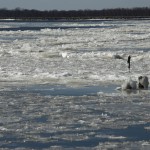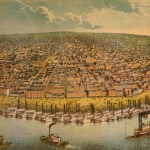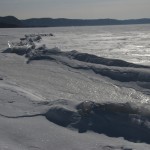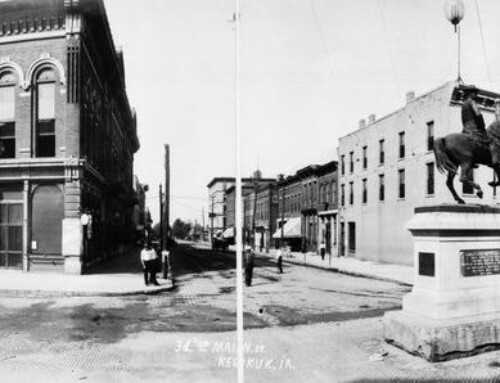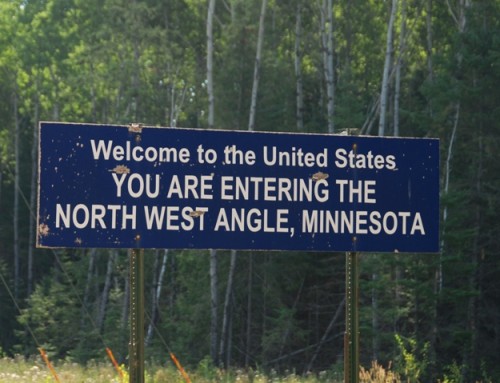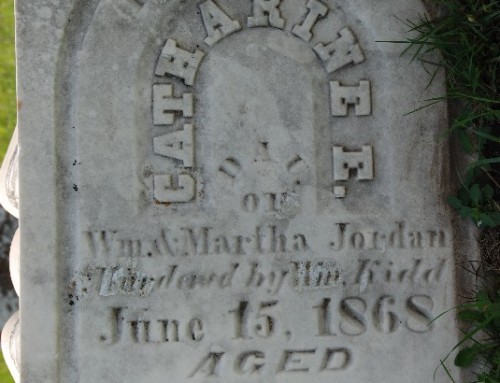As I was scraping ice off my windshield again the other morning, my mind began to wander to things like: How much would it cost to live in New Orleans for the winter? And, frozen bird shit is easier to scrape off the car than the liquid variety.
I also got to thinking about ice on the Mississippi River. In the past, it wasn’t unusual for the river to freeze over as far south as St. Louis or even Cape Girardeau (Missouri). I’ve read newspaper accounts of folks using the frozen river as an ice bridge in 19th century St. Louis. While the Mississippi freezes over almost every year from about the Quad Cities north, in my 25 years in St. Louis, I’ve never seen the river frozen here. I imagine that is partly because of the mild winters we’ve had in that time (except for this year) and partly because of the way the river channel has been narrowed through the city since the 19th century—a faster flowing river is less likely to freeze.
In the past, though, the combination of ice and flowing water could create quite a scene, like the drama that unfolded in February of 1856. Late February had been spring-like; a few days near the end of the month had been warm enough for several steamboats to arrive and unload. The ice that had covered much of the river north of St. Louis was starting to crack and cleave, and the chunks that broke apart would sometimes pile up to form a temporary dam.
On Monday the 25th, one of those jams formed upriver from the St. Louis levee at the Marine Railway around the time that a downriver jam at Mill Creek broke; the two events quickly drained the Mississippi of 8 feet of water at the levee, stranding several boats. But that was merely the beginning. Once the water started moving again, sheets of ice passed under some boats, lifting them up and carrying them down river. After they were dumped on islands or sand bars, passing ice sliced apart the hulls.
On the 26th, the Mississippi upriver from St. Louis (at Alton, Illinois) rose 10 feet after a jam on the Missouri River broke. At St. Louis, river levels fluctuated wildly, down several feet by 11am, then up 3 feet in three hours. By 2pm, word had spread around town that the river was doing something exciting, so hundreds of people headed down to the levee to watch the show. When a big sheet of ice slid by, flipping a boat onto the levee like a little rubber ducky, a mild panic set in and the crowd scattered.
Just ten minutes later, as a single huge piece of ice floated by the levee, fire bells were sounded in alarm, warning everyone to get away from the levee. Some 20 people who had been walking across the ice just before it began to move were nearly swept away as the ice groaned and slid apart, but they managed to get aground at the foot of Chestnut Street.
For a few minutes the river quieted down, as ice crawled downriver almost imperceptibly slowly. The appearance of calm was shattered when the steamer Submarine No. 4 capsized and floated into another steamer, the Federal Arch, triggering a chain reaction that swept away several boats from the levee, igniting one loud boom after another. The river’s flow compressed the wreckage into a single mass and slammed it into dozens of smaller boats, all crushed under the weight of the steamboat debris.
After another hour passed, an observer noted that the ice coming down river had a “frothy, crumbled condition”, with a few big chunks of ice floating in the mix. All that ice eventually slowed down and came to a complete stop around 5:30pm, coalescing into a jam downriver at Cahokia Bend. In just 30 minutes the river rose 10 feet behind the gorge, flooding the St. Louis levee, floating the steamboat wreckage, and, in all likelihood, drowning a few onlookers who had stuck around to watch the show. By 7pm a steady rain was falling when the downriver jam finally broke and the water started flowing for good.
The ice claimed ten steamboats, including the Shenandoah, the G.W. Sparhawk, the Sam Cloon, the Submarine No. 4, the Federal Arch, and the Highland Mary; dozens of small boats were lost, too. A week later, though, the ice was gone and the boats were running normally again.
Cold weather also created a few headaches in the winter of 1989 when large chunks of ice formed in the Mississippi River north of St. Louis from the Missouri River confluence to the head of the Chain of Rocks canal. The jam had closed the Mississippi, which displeased shipping interests. Ken Kruchowski, a spokesman for the Corps of Engineers was quoted as saying “I don’t know if there’s much of anything we can do about it. The industry wants us to blow it up or something like that. But it’s got a head of water behind it. If you took that thing out suddenly and let the ice go with that kind of water behind it, who knows what kind of damage you might do.”
The Corps didn’t dynamite the jam, instead waiting a little while for the river to clear up its own mess. This winter has been another cold one throughout the Mississippi Valley. I don’t know if we’ll get any big jams like we’ve seen in the past, but, if we do, I advise you to keep a safe distance as you watch the river clear itself up.
Sources:
Missouri Daily Republican, 2/27/1856; Missouri Democrat, 2/27/1856; Lodi New-Sentinel, December 21, 1989
© Dean Klinkenberg, 2014
